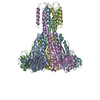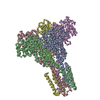+ Open data
Open data
- Basic information
Basic information
| Entry | Database: PDB / ID: 7nh9 | |||||||||||||||||||||||||||
|---|---|---|---|---|---|---|---|---|---|---|---|---|---|---|---|---|---|---|---|---|---|---|---|---|---|---|---|---|
| Title | structure of the full-length CmaX protein | |||||||||||||||||||||||||||
 Components Components | CmaX protein | |||||||||||||||||||||||||||
 Keywords Keywords | TRANSPORT PROTEIN / divalent transport / zinc transporter / CorA family / membrane protein | |||||||||||||||||||||||||||
| Function / homology |  Function and homology information Function and homology informationmetal ion transmembrane transporter activity / nickel cation transport / cobalt ion transport / zinc ion transport / plasma membrane Similarity search - Function | |||||||||||||||||||||||||||
| Biological species |  | |||||||||||||||||||||||||||
| Method | ELECTRON MICROSCOPY / single particle reconstruction / cryo EM / Resolution: 3.03 Å | |||||||||||||||||||||||||||
 Authors Authors | Stetsenko, A. / Stehantsev, P. / Guskov, A. | |||||||||||||||||||||||||||
| Funding support | 1items
| |||||||||||||||||||||||||||
 Citation Citation |  Journal: Int J Biol Macromol / Year: 2021 Journal: Int J Biol Macromol / Year: 2021Title: Structural and biochemical characterization of a novel ZntB (CmaX) transporter protein from Pseudomonas aeruginosa. Authors: Artem Stetsenko / Pavlo Stehantsev / Natalia O Dranenko / Mikhail S Gelfand / Albert Guskov /   Abstract: The 2-TM-GxN family of membrane proteins is widespread in prokaryotes and plays an important role in transport of divalent cations. The canonical signature motif, which is also a selectivity filter, ...The 2-TM-GxN family of membrane proteins is widespread in prokaryotes and plays an important role in transport of divalent cations. The canonical signature motif, which is also a selectivity filter, has a composition of Gly-Met-Asn. Some members though deviate from this composition, however no data are available as to whether this has any functional implications. Here we report the functional and structural analysis of CmaX protein from a pathogenic Pseudomonas aeruginosa bacterium, which has a Gly-Ile-Asn signature motif. CmaX readily transports Zn, Mg, Cd, Ni and Co ions, but it does not utilize proton-symport as does ZntB from Escherichia coli. Together with the bioinformatics analysis, our data suggest that deviations from the canonical signature motif do not reveal any changes in substrate selectivity or transport and easily alter in course of evolution. | |||||||||||||||||||||||||||
| History |
|
- Structure visualization
Structure visualization
| Movie |
 Movie viewer Movie viewer |
|---|---|
| Structure viewer | Molecule:  Molmil Molmil Jmol/JSmol Jmol/JSmol |
- Downloads & links
Downloads & links
- Download
Download
| PDBx/mmCIF format |  7nh9.cif.gz 7nh9.cif.gz | 288.7 KB | Display |  PDBx/mmCIF format PDBx/mmCIF format |
|---|---|---|---|---|
| PDB format |  pdb7nh9.ent.gz pdb7nh9.ent.gz | 236.3 KB | Display |  PDB format PDB format |
| PDBx/mmJSON format |  7nh9.json.gz 7nh9.json.gz | Tree view |  PDBx/mmJSON format PDBx/mmJSON format | |
| Others |  Other downloads Other downloads |
-Validation report
| Summary document |  7nh9_validation.pdf.gz 7nh9_validation.pdf.gz | 839.6 KB | Display |  wwPDB validaton report wwPDB validaton report |
|---|---|---|---|---|
| Full document |  7nh9_full_validation.pdf.gz 7nh9_full_validation.pdf.gz | 868.5 KB | Display | |
| Data in XML |  7nh9_validation.xml.gz 7nh9_validation.xml.gz | 49.1 KB | Display | |
| Data in CIF |  7nh9_validation.cif.gz 7nh9_validation.cif.gz | 68.2 KB | Display | |
| Arichive directory |  https://data.pdbj.org/pub/pdb/validation_reports/nh/7nh9 https://data.pdbj.org/pub/pdb/validation_reports/nh/7nh9 ftp://data.pdbj.org/pub/pdb/validation_reports/nh/7nh9 ftp://data.pdbj.org/pub/pdb/validation_reports/nh/7nh9 | HTTPS FTP |
-Related structure data
| Related structure data |  12321MC M: map data used to model this data C: citing same article ( |
|---|---|
| Similar structure data |
- Links
Links
- Assembly
Assembly
| Deposited unit | 
|
|---|---|
| 1 |
|
- Components
Components
| #1: Protein | Mass: 41365.020 Da / Num. of mol.: 5 Source method: isolated from a genetically manipulated source Details: N-terminal His tag and thrombin cleavage site Source: (gene. exp.)  Pseudomonas aeruginosa (strain ATCC 15692 / DSM 22644 / CIP 104116 / JCM 14847 / LMG 12228 / 1C / PRS 101 / PAO1) (bacteria) Pseudomonas aeruginosa (strain ATCC 15692 / DSM 22644 / CIP 104116 / JCM 14847 / LMG 12228 / 1C / PRS 101 / PAO1) (bacteria)Strain: ATCC 15692 / DSM 22644 / CIP 104116 / JCM 14847 / LMG 12228 / 1C / PRS 101 / PAO1 Gene: cmaX, PA1773 / Production host:  Has protein modification | N | |
|---|
-Experimental details
-Experiment
| Experiment | Method: ELECTRON MICROSCOPY |
|---|---|
| EM experiment | Aggregation state: PARTICLE / 3D reconstruction method: single particle reconstruction |
- Sample preparation
Sample preparation
| Component | Name: CmaX protein pentamer / Type: COMPLEX / Entity ID: all / Source: RECOMBINANT |
|---|---|
| Molecular weight | Experimental value: NO |
| Source (natural) | Organism:  |
| Source (recombinant) | Organism:  |
| Buffer solution | pH: 8 |
| Specimen | Embedding applied: NO / Shadowing applied: NO / Staining applied: NO / Vitrification applied: YES |
| Vitrification | Cryogen name: ETHANE |
- Electron microscopy imaging
Electron microscopy imaging
| Experimental equipment |  Model: Titan Krios / Image courtesy: FEI Company |
|---|---|
| Microscopy | Model: FEI TITAN KRIOS |
| Electron gun | Electron source:  FIELD EMISSION GUN / Accelerating voltage: 300 kV / Illumination mode: FLOOD BEAM FIELD EMISSION GUN / Accelerating voltage: 300 kV / Illumination mode: FLOOD BEAM |
| Electron lens | Mode: BRIGHT FIELD |
| Image recording | Electron dose: 60 e/Å2 / Film or detector model: GATAN K3 BIOQUANTUM (6k x 4k) |
- Processing
Processing
| Software | Name: PHENIX / Version: 1.16_3549: / Classification: refinement | ||||||||||||||||||||||||
|---|---|---|---|---|---|---|---|---|---|---|---|---|---|---|---|---|---|---|---|---|---|---|---|---|---|
| EM software | Name: PHENIX / Category: model refinement | ||||||||||||||||||||||||
| CTF correction | Type: NONE | ||||||||||||||||||||||||
| 3D reconstruction | Resolution: 3.03 Å / Resolution method: FSC 0.143 CUT-OFF / Num. of particles: 243386 / Symmetry type: POINT | ||||||||||||||||||||||||
| Refine LS restraints |
|
 Movie
Movie Controller
Controller











 PDBj
PDBj